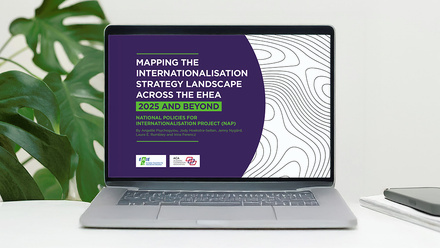Education, aspiration, action: solving the job skills mismatch

The third essay in the 2020 Conversation Starter series invites a critical glance at the disconnect between the skills offered by university graduates and the skills demanded by the industries they will go on to work in. Do student expectations of employability align with the reality that awaits them, and if not then what role can higher education institutions play in closing the gap?
Young people around the world are more educated than ever before, but that’s a potential problem. If markets are flooded with qualified or overqualified job applicants, and if most young people apply for only a narrow subset of jobs, then recent graduates will not find employment, or they will be underemployed – ie, relegated involuntarily to part-time work. In fact, before the COVID-19 pandemic caused skyrocketing unemployment in the United States this year, involuntary part-time workers made up about 1.0% of all those employed in the US, while the OECD average is about three times higher at 3.1%. In the EU, the underemployment rate – again, pre-pandemic – was even higher, at about 4.6%; however, there are significant differences by country. For example, pre COVID-19 underemployment stood at just 1.7% in Croatia and 4.6% in Montenegro, but 8.3% in Spain and 11.9% in Italy.
Underemployment is one side of a more complicated story. Setting aside the financial and economic disruption brought about by the pandemic, employers have been looking for employees, but encountering a serious skills/job mismatch. For example, as recently as January 2020, Italian companies were reportedly looking to hire about one million new graduates, but about 30% of that demand was expected to go unmet. That unmet demand is greatest in the fields of physics and chemistry, where the skill/job mismatch is over 65%. In the fields of data science, data analysis, digital marketing, and 4.0 engineering, the skill/job mismatch stands at about 40%.
The co-existence of unemployed university graduates and employers unable to fill vacancies has implications for the field of international education
Employability is an important issue for many, including international education professionals. Indeed, international students’ satisfaction and propensity to recommend their institution are deeply influenced by things like the development of employability skills, work experience, and career guidance. Therefore, the co-existence of unemployed university graduates and employers unable to fill vacancies not only indicates a significant divide between the education world and the employment world, but also has implications for the field of international education. Ultimately, while producing well-educated young people is a great achievement for the education community around the world, the skills mismatch present in many countries "shows that more education does not automatically mean better jobs and better lives". So, how did we get here and what can be done?
Aspiration: a key variable
Globalisation has delivered transformative economic and social changes to the work landscape. And the OECD’s Programme for International Student Assessment (PISA) was designed to look at how students from OECD countries were responding to that changing landscape by measuring literacy, mathematics, science and problem-solving performance. As Amanda Ripley, author of The Smartest Kids in the World: And How They Got That Way, rightly states, the architect of PISA, Andreas Schleicher, designed a test that "wasn’t measuring memorization; it was measuring aspiration". In fact, according to the book, "[e]conomists found an almost one-to-one match between PISA scores and a nation's long term economic growth. Many other things influenced economic growth, of course, but the ability of a workforce to learn, think, and adapt was the ultimate stimulus package". Titans of innovation, such as Bill Gates, share the same perspective, noting "In the long run, your human capital is your main base of competition. Your leading indicator of where you're going to be 20 years from now is how well you're doing in your education system".
Importantly, PISA also collects information on the career aspirations expressed by the adolescents who participate in these testing exercises. Comparing data from the 2018 PISA career aspirations section to those from 2000 produces a very clear picture of how young people’s career aspirations have changed and how they match (or not) to market demands. Specifically, the data indicates that adolescent expectations have become more concentrated in fewer occupations, such that 47% of adolescent boys and 53% of adolescent girls in 2018 – compared to 38% and 49%, respectively, in 2000 – expect to be employed in one of just ten professions by the time they reach age 30.
As investment in human capital increases, 15 year-olds are more likely to see a wider variety of jobs as possible for them
These dynamics play out in striking ways, as we found in a recent project we undertook that involved integrating the data from the OECD’s PISA Dream Jobs study and the World Bank’s Human Capital Project – ie, the Human Capital Index (HCI). The Human Capital Project is a global effort led by the World Bank to look at how a country’s investment in its youth via early health care and education can help children succeed and prosper as adults in a globalised work landscape.
An example comparing Germany and Indonesia illustrates our findings. The 2018 OECD PISA data indicate that 38% of German 15 year-olds expect to be employed in one of just ten jobs by the time they reach 30, compared to 68% of Indonesian 15 year-olds. Meanwhile, the World Bank’s HCI data indicates that Germany invests 26% more than Indonesia in its human capital. Indeed, as investment in human capital increases, 15 year-olds are more likely to see a wider variety of jobs as possible for them.
National and regional insights
Employability and education dynamics play out differently in specific national and regional contexts. Italy, Croatia and Montenegro offer one set of insights into a particular corner of Europe. According to the 2018 PISA survey in Italy, 72% of students expect to work in a highly-skilled occupation, such as a professional or a manager. However, 25% do not plan to complete tertiary education, with disadvantaged students disproportionately represented among those not planning to complete. The situation in Croatia is quite similar to that in Italy, though less acute in Montenegro.
A variety of factors contributes to these dynamics. In Italy, for example, the Humboldtian model of the university still prevails. Higher education in Italy is almost entirely dominated by research type universities, while institutions that resemble Northern Europe’s universities of applied sciences enroll only about 16,000 students, or approximately 1% of the total university student body in Italy. By comparison, some 1 million students in Germany are enrolled at universities of applied sciences, which constitutes about 35% of the total university student body.
Finding creative ways to more closely align educational offerings and society’s needs for economic development is vital
Italy also has one of the lowest university graduate percentages in the EU – 27% versus a European average of about 40%. As a percentage of the total population, enrolment in higher education is less than 3% in Italy versus 3.75% in Germany, almost 5% in Canada and 6% in the US. Meanwhile, work-integrated learning (WIL) or co-op programs in Italy are almost absent.
The Croatian higher education system is not so different from the Italian one, however, in Montenegro, the situation differs for a number of reasons. It is a small country, with only about 600,000 citizens. There is only one public university, the University of Montenegro, where most departments have very close relationships with industry and have embedded in their traditional curricula more vocational programmes.
Where does that leave us?
We know that the structure of the higher education system in a country is strongly linked to career expectations and the skills gap. In Northern European countries, where the vocational higher education system is effective and well developed, the skills gap is much smaller. So, elsewhere, finding creative ways to more closely align educational offerings and society’s needs for economic development is vital. Just as important, however, is career guidance for young people, which has never been as important as it is now. There needs to be a symbiotic relationship between industry and universities to help young people understand job and career options and to develop curricula that create a smooth transition from formal educational settings into the world of work.
International higher education professionals and specialists in our particular part of Europe (Italy, Croatia and Montenegro) as in many other contexts, need to be aware that there is a skills mismatch between what the market is asking for and what students are prepared for by their tertiary education system. That mismatch in a globalised world means that career expectations are concentrated for many in an unimaginatively small range of employment possibilities.
The path to recovery from the COVID-19 pandemic, for our societies and our economies, is going to require creativity and tenacity. Greater investment by countries in the health and education of their young people, stronger commitment to improving vocational higher education systems, and high-quality career advising appropriate to this age of hyper-connectivity between local and global realities can all drive down the skills mismatch, which is vital for the future. Creating the conditions that make these developments possible requires creative solutions and our sustained attention.
Questions for discussion
- To what extent do you perceive that there is a skills/job mismatch in your geographical area or country? What are some of the possible explanations for this situation? How can internationalisation help mitigate such situations?
- What role(s) do you see for universities of applied sciences, and/or vocational higher education institutions to help resolve skills/job mismatches, particularly in a globalised economy? What role do you think internationalisation strategies have at these types of institutions to help resolve skills/job mismatches?
- Do you think that a country’s lack of investment in its human capital is a good explanation for the skills/job mismatch? If not, what else do you think can explain it?
- What can universities do to help their students – domestic and international – consider their working lives more broadly and creatively?






